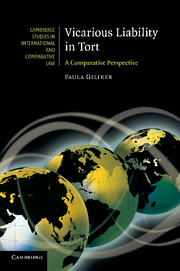Book contents
- Frontmatter
- Contents
- Diagrams
- Table of cases
- Table of legislation
- Preface
- 1 What is vicarious liability?
- 2 Establishing a general framework for liability
- 3 The employer/employee relationship: identifying the contract of employment
- 4 Special difficulties: borrowed employees and temporary workers
- 5 Other relationships giving rise to liability
- 6 Acting in the course of one's employment/functions/assigned tasks: determining the scope of vicarious liability
- 7 Parental liability for the torts of their children: a new form of vicarious liability?
- 8 Understanding vicarious liability: reconciling policy and principle
- 9 A postscript: a harmonised European law of vicarious liability?
- Appendix: Key provisions of the French and German Civil Codes
- Index
- Titles in the series
3 - The employer/employee relationship: identifying the contract of employment
Published online by Cambridge University Press: 10 November 2010
- Frontmatter
- Contents
- Diagrams
- Table of cases
- Table of legislation
- Preface
- 1 What is vicarious liability?
- 2 Establishing a general framework for liability
- 3 The employer/employee relationship: identifying the contract of employment
- 4 Special difficulties: borrowed employees and temporary workers
- 5 Other relationships giving rise to liability
- 6 Acting in the course of one's employment/functions/assigned tasks: determining the scope of vicarious liability
- 7 Parental liability for the torts of their children: a new form of vicarious liability?
- 8 Understanding vicarious liability: reconciling policy and principle
- 9 A postscript: a harmonised European law of vicarious liability?
- Appendix: Key provisions of the French and German Civil Codes
- Index
- Titles in the series
Summary
Introduction
The next three chapters will address the first element of any vicarious liability claim: the need for a particular relationship between the defendant and the person for whom he is rendered strictly liable. The most common example of this relationship is that of the employer/employee (or, to use civilian terminology, the commettant/préposé or Geschäftsherr/ Verrichtungsgehilfe). From the nineteenth century onwards, industrialisation has rendered this particular relationship of increasing significance in terms of the damage which could be caused by employees and, with the advent of insurance, the financial ability of the employer to provide compensation. At the very heart of this doctrine, in both common and civil law, therefore, lies the employer/employee relationship.
In examining the scope of this relationship across common and civil legal systems, a common starting point may be identified: control. Whether interpreted as the ability to control, instruct or exert authority over the employee, all the systems surveyed in this book perceive this element as the key characteristic of the employment relationship. Nevertheless, as will be seen, changes in employment practices, the rise of the professional and increased use of technology have diminished the utility of this test and led to its reappraisal in relation to modern employment relations. It can no longer be assumed that an employee will act under the absolute control of his superior. Employees will often be expected to act independently, show initiative, and make on-the-spot decisions without recourse to their superior.
- Type
- Chapter
- Information
- Vicarious Liability in TortA Comparative Perspective, pp. 55 - 80Publisher: Cambridge University PressPrint publication year: 2010
- 1
- Cited by



